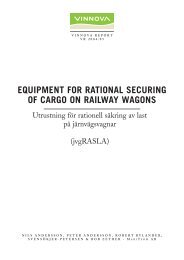Download - Autosim Autosim
Download - Autosim Autosim
Download - Autosim Autosim
You also want an ePaper? Increase the reach of your titles
YUMPU automatically turns print PDFs into web optimized ePapers that Google loves.
CURRENT & FUTURE TECHNOLOGIES IN AUTOMOTIVE ENGINEERING SIMULATION<br />
4.4.4.4 Validation – Current/Best Practices<br />
Typically the practice of assessing the accuracy of a model relies on<br />
subjective comparisons of a model’s predictions against test results. This<br />
practice relies on the analyst or model developer providing a subjective<br />
assessment on the confidence of the models accuracy based on their<br />
understanding of the model’s structure and the inherent assumptions made<br />
in the development of the model possess. As such this practice of<br />
assessing a model’s accuracy is open to interpretation, can be misleading<br />
and does not provide any direct means of comparing the accuracy of one<br />
model’s predictions against another.<br />
Objective methods of validating the predictions from models would provide<br />
a more consistent understanding of a model’s predictive accuracy and a<br />
relative appreciation on the accuracy of one model compared with that of<br />
another. Examples of subjective methods of comparing model predictions<br />
against test results have been developed (e.g. MODEVAL and MAC).<br />
However, so far it is understood that these are generally only applicable for<br />
validating models under specific loading conditions and they can also<br />
provide misleading results. The current understanding is that further work is<br />
needed to develop robust objective validation practices.<br />
Uncertainties in the structure and assumptions made in the development of<br />
a model can have an influence on its accuracy and the confidence that can<br />
be placed in its behaviour. Parametric and sensitivity studies can be used<br />
as a best practice to explore the uncertainties and assumptions in the<br />
model’s construction in order to develop confidence in its behaviour.<br />
Similarly stochastic modelling studies can be carried out to assess the<br />
robustness of a model’s behaviour by comparing the spread of data<br />
produced from stochastic studies against comparable sets of test data. An<br />
outcome of parametric or stochastic modelling studies could be to define<br />
specific loading conditions under which a model can and cannot be applied<br />
or they could be used to help define confidence limits for the model’s<br />
predictions. In practice, restrictions on the available time and resources to<br />
carry out test and modelling work limits the amount of parametric, sensitivity<br />
or stochastic modelling work that is carried out to validate the robustness of<br />
model predictions.<br />
Confidence in the accuracy and behaviour of models can be developed<br />
through the gradual building and validation of a model’s complexity. For<br />
instance, the models of individual components that form an assembly<br />
should be developed and validated in isolation prior to their inclusion in a<br />
complete model of the assembly. As such there will be greater confidence in<br />
the behaviour of the assembly model because of this gradual and<br />
methodical approach in its development.<br />
38 |<br />
SIXTH FRAMEWORK PROGRAMME PRIORITY [6.2] [SUSTAINABLE SURFACE TRANSPORT]<br />
012497 AUTOSIM
















